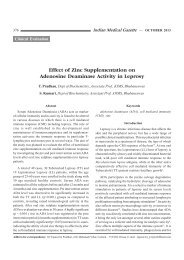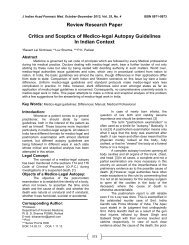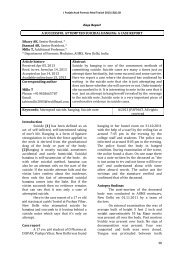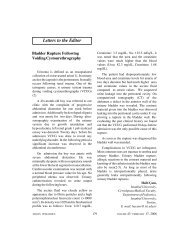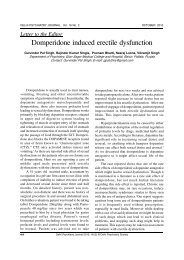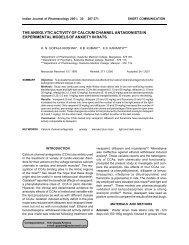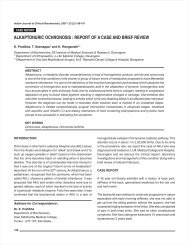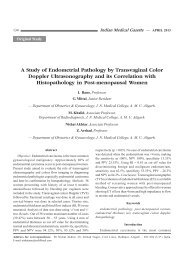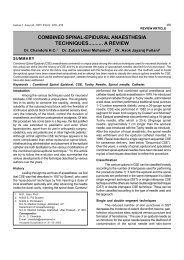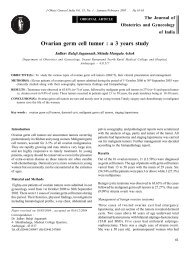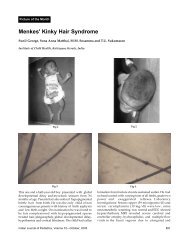You also want an ePaper? Increase the reach of your titles
YUMPU automatically turns print PDFs into web optimized ePapers that Google loves.
confused with a positive Babinski’s sign. It is characterised<br />
by a dorsiflexion of the ankle alongwith hip and knee<br />
flexion. In such a situation, it is important to repeat the<br />
stimulus more gently and hold the foot at the ankle, or try<br />
alternative stimuli. A true Babinski sign can be clinically<br />
distinguished from the false Babinski by a failure to inhibit<br />
the extensor response by pressure over the base of the<br />
great toe. Moreover, unlike the voluntary withdrawal of<br />
the toes, the true Babinski sign is reproducible.<br />
<br />
movement of the big toe. The toe could be so retracted<br />
as to appear to be in the extensor position to start with.<br />
In such a situation, it is important to observe the<br />
movement at the metatarsophalangeal joint because<br />
if the terminal joint alone is observed, a further<br />
extension of the same may be quite misleading.<br />
An equivocal response is sometimes observed and is<br />
difficult to interpret.<br />
Fallacies in the interpretation of the plantar<br />
response<br />
<br />
<br />
<br />
<br />
<br />
No response to the plantar stimulus may be observed<br />
in certain situations. Patients with callosities of the feet<br />
may be unable to feel the plantar sensation. Sensory<br />
loss in the S1 dermatome may be encountered in<br />
patients with peripheral neuropathy or tibial nerve<br />
injury and it interferes with the afferent limb of the<br />
reflex arc leading to an absence of the reflex.<br />
Cases with proven damage to the pyramidal system<br />
may have a normal plantar response. The possible<br />
explanation for this is that corticospinal fibres not only<br />
originate in different parts of the cortex, but also have<br />
different terminations. Babinski sign can be expected<br />
only when the leg fibres of the pyramidal tract are<br />
involved.<br />
An extensor plantar response may be obtained in the<br />
absence of damage to the pyramidal tract due to<br />
possible dissociation of the nerve fibres in the spinal<br />
reflex arc, with excitation of the distal motor neurons<br />
and inhibition of the impulses via flexor reflex afferent<br />
nerve fibres, since they are mediated by different<br />
neurons.<br />
Babinski response may not be observed in UMN lesions<br />
with complete paralysis of the extensors of the toes.<br />
The toes are unable to extend due to a total paralysis<br />
of the muscles. In such cases, contraction of the tensor<br />
fasciae latae may be taken as a positive sign.<br />
Bony deformities like ‘hallux valgus’ may prevent any<br />
movement of the big toe. In such a situation it is<br />
important to observe the movement of the other toes.<br />
Role of videotape and EMG in the<br />
interpretation of the <strong>Plantar</strong> Response<br />
A positive Babinski sign is confirmed if:<br />
<br />
<br />
The upward movement of the great toe is caused by<br />
contraction of the extensor hallucis longus muscle<br />
(EHL).<br />
Contraction of the EHL occurs synchronously or<br />
concurrently with reflex activity in other flexor<br />
muscles that may or may not be brisk enough to be<br />
appreciated visually.<br />
Videotaping and EMG can thus aid the clinical<br />
interpretation in patients with unexpected finding or<br />
an equivocal response.<br />
Alternate methods to elicit the extensor<br />
plantar response<br />
The method of Babinski is probably the most sensitive and<br />
reliable method for elicitation of the plantar reflex, but<br />
may at times fail to do so or produce an equivocal<br />
response. Other methods can then be used to elicit the<br />
response and include some of following techniques:<br />
<br />
<br />
<br />
<br />
Chaddock’s sign: The stimulus is applied along the<br />
lateral aspect of the foot, below the external malleolus.<br />
Oppenheim’s reflex: Firm pressure is applied along<br />
the shin of the tibia from below the knee upto the<br />
ankle with the knuckles of the examiner’s index and<br />
middle finger.<br />
Gordan’s sign: The calf muscle is squeezed.<br />
Schaefer’s sign: Squeezing the Achilles tendon.<br />
<br />
In patients with ‘pes cavus’ it is difficult to assess the<br />
<br />
Gonda’s sign: The fourth toe is pressed downwards<br />
196 Journal, Indian Academy of Clinical Medicine Vol. 6, No. 3 July-September, 2005



